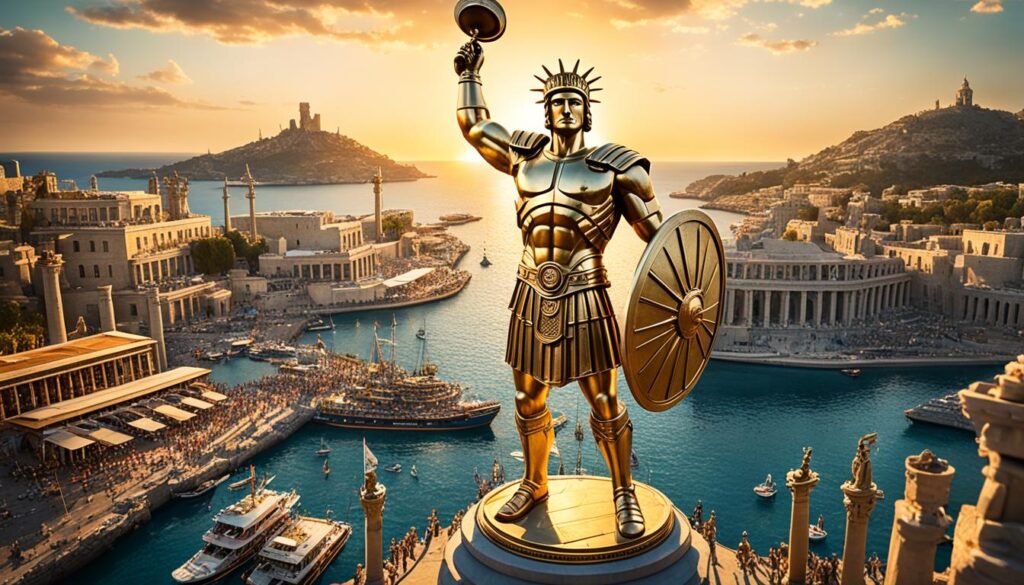The Colossus of Rhodes was a Greek statue and ancient wonder. It stood tall for just 55 years. Despite its short time, it made a big impact on history.
It was built to honor Helios, the Greek sun god. This huge statue showed Rhodes’ victory over a siege. It was a symbol of strength and resilience.
Chares of Lindos, a talented Greek sculptor, worked on it for 12 years. The Colossus of Rhodes was 108 feet tall. It likely stood at the eastern side of Rhodes’ harbor, welcoming visitors to the island.
The statue was made after Rhodes beat Demetrius I of Macedon in 305 BCE. It became a symbol of Rhodes’ power and strength. Even though it didn’t last long, the Colossus is still remembered as one of the Seven Wonders of the Ancient World.
Its brief existence reminds us that even the greatest human achievements can be short-lived. Learn more about other interesting historical facts.
Key Takeaways
- The Colossus of Rhodes stood for approximately 55 years
- It was a 108-foot tall statue of Helios, the Greek sun god
- Greek sculptor Chares of Lindos built it over 12 years
- The statue commemorated Rhodes’ victory over Demetrius I
- It was likely located on the eastern side of Rhodes’ harbor
- The Colossus is one of the Seven Wonders of the Ancient World
The Rise and Fall of an Ancient Wonder
The Colossus of Rhodes was born from an unexpected source. Funds from Demetrius I’s army helped create this massive bronze statue. It stood as a symbol of Rhodes for about 50 years.
But its life was short-lived. In 226 BCE, a strong earthquake struck, bringing it down. The statue’s pieces were scattered all over the island. For many years, they lay there, reminding people of its grandeur.
Then, in 654 CE, the Arabs invaded and took the statue’s remains. They saw the bronze as valuable. It took over 900 camels to move all the pieces away.
Rhodians thought about rebuilding their iconic statue. But the oracle of Delphi warned them not to. The oracle said Helios, the sun god, was unhappy. This was like the secret talks between leaders in tough times.
Even though it didn’t last long, the Colossus of Rhodes made a big impact. Its story still amazes and inspires people today, long after it fell.
Colossus of Rhodes’ Brief Existence: A Historical Perspective

The Colossus of Rhodes was a huge achievement in ancient times. It lasted only 55 years but made a lasting impact. People like Antipater of Sidon called it one of the Seven Wonders of the World.
Artists have shown the Colossus in many ways over time. Some see it as a strong Helios holding a torch, surrounded by sun rays. This idea has inspired many people through the ages.
The Statue of Liberty is a great example of this influence. French sculptor Frédéric-Auguste Bartholdi was inspired by the Colossus. He used its symbolism and look to create a symbol of hope and freedom in America.
Even though it didn’t last long, the Colossus of Rhodes still fascinates us. It shows what humans can achieve and how art can inspire us for centuries.
Legacy and Modern Reimaginations of the Colossus
The Colossus of Rhodes still inspires us today. Its legacy sparks new ideas for rebuilding this ancient marvel. In 1999, a plan was set to create a new statue for the 2004 Athens Olympic Games. This project aimed to promote peace and unity among nations.
Later, new ideas came to life. A 2008 concept turned the Colossus into a light show. In 2015, during Greece’s debt crisis, a bold plan was proposed. It envisioned a tall structure as tall as modern skyscrapers. This design included a museum, restaurant, library, and shops. It would serve as both a lighthouse and a tourist spot, boosting tourism revenue.
These new visions mix history with innovation. Many include sustainable energy features like solar panels. They aim to honor the past while meeting today’s needs. These plans show how ancient wonders can inspire modern solutions. They could even revitalize local economies through increased tourism.

Leave a Reply